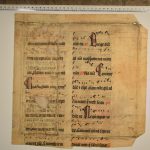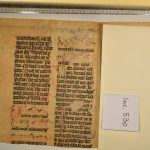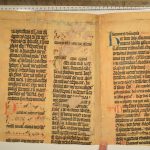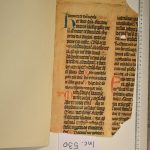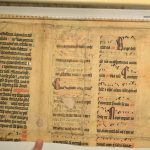The first two pages of the bifolio preserved parts of two sections of the Office of the Dead. Fol. 1 contains chants from the regular Officium Defunctorum arranged in three nocturns: the invitatory (ps. Venite exsultemus, written and notated in full was presumably framed by the antiphon Circumdederunt me), the antiphons (recto), and the first responsory (verso). The chants on fol. 2 belong to the second section of the office. This second unit – usually composed of 9 responsories, with the first being the Credo quod Redemptor – is called ‘alia historia’ or ‘ vigiliae mortuorum minores’ in the majority of the medieval Central-European sources. The surplus responsories definitely were distributed and sang on multiple days according to the occasion and the all-time needs. On the ground of the chants and chant-torsos preserved on fol. 2 of the fragment (without notes) we can reconstruct the Credo quod Redemptor-cycle from its fourth responsory (Heu mihi Domine) to the last (Libera me Domine de morte).
The hymns Conditor alme siderum and Verbum supernum prodiens a Patre reflect the typical Hungarian (Esztergom) melody choice (see Gábriel Szoliva, ed., Psalterium Strigoniense Venetiis 1523, f. 108v, [=Musicalia Danubiana (Budapest: HAS Research Centre for the Humanities, Institute for Musicology, 2015), vol. 25]). However, the prescription of the hymn Te lucis ante terminum amongst the advent hymns is uncommon. In Hungary it occurs in the Pauline choir books, that the materials of the Compline (among them the hymn in question) are written to the Advent section, as this hour is invariant in the Pauline tradition for the most part of the year, hence it could be in a good place at the beginning of the choir books. (See the Pauline antiphoner from Remete convent, Zagreb, Metropolitanska knižnica, MR 8 pp. 2–3; Breviarium Paulinum impr. Venetiis, 1540, ff. 69v, 86r–87r). The hymn Te lucis was sang almost every day of the year (the only exceptions were Christmas and Lent), at the most the ad notam was adjusted to the temporal feasts. Texts of hymns meant to be used with multiple melodies – as can be seen on the fragment – weren’t conventionally notated.
The rubric of the hymn Verbum supernum is „ad nocturnum”, meaning it was sung in the Matins. From hymnaries conveying the Hungarian melody tradition this placement is only known from the Paulines, the same hymn was used in the Compline in Esztergom, Kalocsa-Bács and their dependent dioceses. Based on all this, the Pauline origin of the fragment is highly probable.
The fragments F 725 and 724 from the same psalter can be fitted between the two folios of F 726. These two folios held parts of the second and third nocturns. They can be almost precisely put together: the antiphon Sitivit anima mea, which begins on the verso of F 725, continues on the recto of F 724.
Zsuzsa Czagány, Gábriel Szoliva


